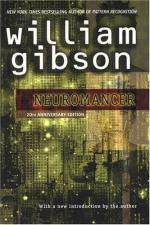|
This section contains 8,763 words (approx. 30 pages at 300 words per page) |

|
SOURCE: Myers, Tony. “The Postmodern Imaginary in William Gibson's Neuromancer.” Modern Fiction Studies 47, no. 4 (winter 2001): 887-909.
In the following essay, Myers examines how Gibson utilizes the concept of cyberspace in Neuromancer to create a postmodern narrative setting.
Much of William Gibson's novel Neuromancer is centered around cyberspace, or the matrix as it is alternatively called, the representational innovation for which his work has become famous. It is first defined for the reader via the narration of a children's educational program: “Cyberspace. A consensual hallucination experienced daily by billions of legitimate operators, in every nation, by children being taught mathematical concepts. … A graphic representation of data abstracted from the banks of every computer in the human system. Unthinkable complexity. Lines of light ranged in the nonspace of the mind, clusters and constellations of data. Like city lights receding …” (67). The concept of cyberspace is valuable as a narrative strategy because...
|
This section contains 8,763 words (approx. 30 pages at 300 words per page) |

|


